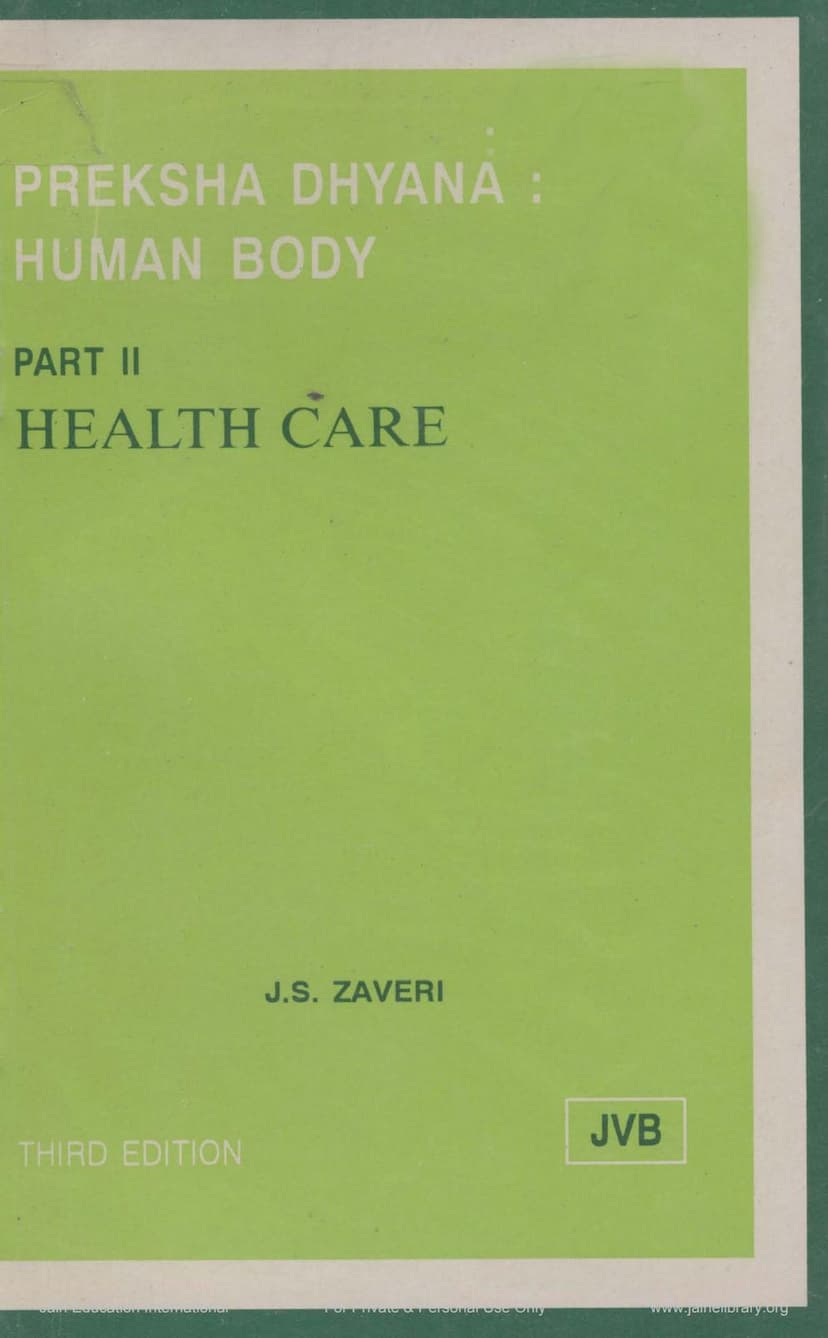Preksha Dhyana Human Body Part 2
Added to library: September 2, 2025

Summary
This book, "Preksha Dhyana: Human Body Part II - Health Care" by J.S. Zaveri, published by Jain Vishva Bharati in 1993, is a continuation of a series on Preksha Dhyana, focusing on the human body and health. It aims to provide readers with a deeper understanding of their physical and mental well-being, emphasizing prevention and natural methods of maintaining health.
The book begins by highlighting the increased importance of healthcare in modern life, stressing that a thorough knowledge of the human body is fundamental. It acknowledges the impact of modern lifestyles, including new chemicals in food and clothing, and urges readers to be aware of how they abuse their internal organs. The author advocates for sensible diet and exercise over reliance on laxatives and pills, and encourages readers to protect their liver, teeth, and lungs from damage.
A key theme is the power of scientific complete breathing (Chapter 1). The book details the process of breathing, explaining the mechanics of inhalation and exhalation and the vital role of oxygen. It emphasizes the importance of nasal breathing, abdominal expansion during inhalation, and the benefits of deep, slow, and complete breathing for overall health, including improved circulation and disease resistance. Various breathing exercises like Alternate Breathing, Bellows Breath, and Cleansing Breath are described. Specific breathing exercises are recommended for asthma and bronchitis patients, along with advice on preventing attacks. The text also touches upon the physiological and mental effects of vocal vibrations, such as reciting vowels.
Chemistry of Life (Chapter 2) introduces the fundamental chemical constituents of the body: water, inorganic salts, carbohydrates, lipids (fats), proteins, and nucleic acids. It explains their functions and importance for cellular processes and overall health.
Nutrition (Chapter 3) delves into the essential components of a balanced diet, including water, carbohydrates, proteins, fats, vitamins, and minerals. It discusses their roles, recommended daily allowances, and the consequences of deficiencies. The chapter also covers caloric requirements, the problem of obesity and dieting, and provides a stage-by-stage plan for a healthier diet.
Metabolism of Food (Chapter 4) explains how the body processes carbohydrates, proteins, and fats to extract energy and build tissues. It details metabolic pathways and the role of enzymes and hormones.
The Dynamic Balance of Body Fluids (Chapter 5) discusses the regulation of total body fluids, the input and output of water, and the body's reserves. It highlights the importance of maintaining fluid balance for homeostasis and discusses practical considerations related to fluid retention and dehydration.
Dysfunctions and Disorders (Chapter 6) provides an overview of common disorders affecting various body systems, including the circulatory (blood clotting, atherosclerosis, hypertension), respiratory (asthma, bronchitis, common cold, influenza, pneumonia, emphysema, lung cancer, tuberculosis), digestive (indigestion, constipation, diarrhea, ulcers, liver diseases), muscular (spasms, atrophy, hypertrophy), and joint systems (sprains, dislocations, fractures, arthritis).
Diseases and (Body's) Defences (Chapter 7) categorizes diseases into bacterial, viral, fungal, parasitic, and degenerative types. It also explains the body's defense mechanisms, including the role of tonsils, antibodies, B and T cells, and immunity. The chapter also touches upon autoimmune diseases and allergies.
Growth, Aging, Death (Chapter 8) examines the processes of growth, aging, and death. It discusses the factors influencing growth, the physiological changes associated with aging, and the biological definition of death. It suggests that lifestyle choices and practices like exercise and meditation can positively influence the aging process.
Health-Hazards (Chapter 9) addresses modern lifestyle challenges that negatively impact health, such as pollution (air, water, noise), drinking, smoking, drug abuse, and improper postures. It emphasizes the detrimental effects of these hazards and suggests that practices like regular exercise and relaxation can help mitigate them.
Relaxation (Chapter 10) explores the "age of tension" and introduces relaxation as a direct antidote. It explains the importance of physiological and mental relaxation for combating stress and promoting well-being. The chapter provides a detailed technique for achieving total relaxation, emphasizing conscious will and mindful practice.
Maintain Emotional Health (Chapter 11) focuses on the crucial link between physical and mental health, introducing the concept of psychosomatic illnesses. It explains the role of the limbic system in emotions and the potential for conflict between primal drives and rational thought. The chapter discusses how psychological conflicts and repression can lead to emotional distortions and mental disorders, and suggests that systematic meditation is a powerful tool for cultivating emotional health by influencing hormonal secretions and promoting a state of equilibrium.
The book concludes with appendices listing important minerals and vitamins required by the body, along with their sources, daily allowances, and the results of their deficiencies.
In essence, "Preksha Dhyana: Human Body Part II - Health Care" is a comprehensive guide that integrates scientific knowledge of the human body with the principles of Preksha Dhyana, offering practical advice for achieving and maintaining physical, mental, and emotional well-being through conscious breathing, proper nutrition, lifestyle choices, and meditation.